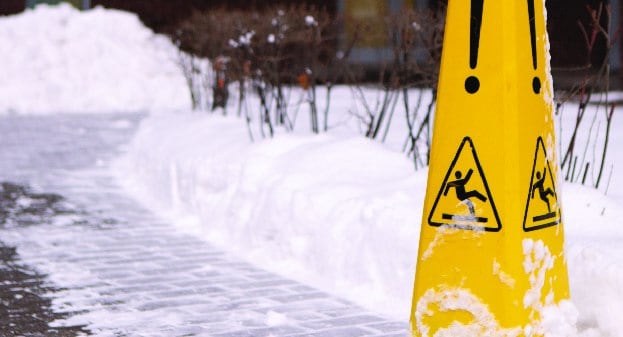Most slip and fall accidents from snow or ice can be prevented with proper maintenance. It is the property owner’s legal responsibility to maintain reasonably safe conditions, including remedying any known cold weather hazards within an adequate amount of time. According to the CDC, approximately 1 million Americans are injured annually as a result of falling on ice and snow.
Cold temperatures, snow and ice, and freeze-thaw cycles can occur from September to May in many areas of Colorado, leaving your property at risk of slip-and-fall accidents for much of the year. As this snow season comes to an end, employees and guests prepare for warmer temperatures, but property owners and managers need to continue to think about their snow management responsibilities now and for next season.
Slip-and-fall settlements, on average, can cost between $10,000 and $50,000. Depending on the incident, a legal settlement can cover medical bills, lost wages, and other accident-related damages. When a slip and fall occurs, it is critical for the property manager or building engineer to document the incident with photos, witness testimonies, and security camera footage, as these can be used as evidence to help chronicle the events that unfolded.
In Colorado, commercial properties are required to remove snow within four hours after snow has stopped falling. Therefore, it is critical to work with an Accredited Snow Contractors Association (ASCA) certified snow removal provider. ASCA certified snow management companies go through extensive and on-going risk-management based training to learn how to service the property, focus on documentation, improve standards, and reduce risk.
Hiring an ASCA-certified snow management provider ensures your property is properly maintained and places an emphasis on hazard detection. Hazards can lead to a slip-and-fall claim on your property. Most slip and fall claims are not made during the storm, and the Colorado law states the statute of limitation for a slip and fall claim is two years from the accident date.
As of May 2018, Colorado became the second state in the nation to prohibit a property owner from passing all liability on to snow and ice management contractors. That means, owners, building management companies, and contractors can all be liable in a slip and fall claim. Therefore, it is extremely important that property managers, owners, and snow contractors keep detailed records of all slip and fall incidents. The more documentation available, the better chance a claim will not result in litigation.
If a slip and fall claim occurred on your property during this snow season and your snow management provider did not have proper documentation to help support the case, it may be time to evaluate your provider.
When hiring a snow contractor, it is important to ensure they have a thorough understanding of your property: learn the layout of your property along with drainage areas, slope, and parking, proactively plan snow pile areas, keep detailed documentation of each snow event, and inform you of any potential slip and fall hazards during their service period.
The fluctuation in Colorado temperatures cause regular freeze-thaw cycles. Due to these cycles, hazardous conditions not only develop from snow melt, but also from water draining from broken or leaky gutters. The pools and streams of water that accumulate during freeze-thaw cycles can flow onto walkways, driveways, and parking lots, quickly turning to ice when temperatures drop, and create slip and fall risks.
Beyond hiring the proper snow management provider, property managers can mitigate the risk of slip-and-falls on a property by implementing these simple tips:
- Repair asphalt parking lots and driveways before the first snow fall
- Repair or replace broken or leaky gutter systems and other potentially hazardous areas prior to the snow season
- Apply ice melt chemicals to promote the elimination of ice
- Keep large mats and drying areas near entryways so visitors can avoid tracking excess water onto hard surfaces
- Exercise proper care to keep floors dry
- Post warning signs reminding visitors to watch for slippery areas
Improving slip and fall risks starts with preemptive planning. Ensure any potential hazards are fixed before the snow season and hire a certified snow management provider who is proactive about inspecting, documenting, and communicating about your property’s conditions before, during, and after a snow event.
Slip and fall incidents can be costly, but they are also preventable. Give customers and yourself a reason to enjoy the snow season by proactively diminishing the probability of a slip and fall on your property.

